via https://youtu.be/dRd5mVksDBQ
from WordPress https://logicinbound.wordpress.com/2018/01/29/stacking-growth-summit-ii/

In the overwhelming age of the internet, it can be difficult to break through the noise with your marketing content. With easily accessible content coming at consumers from every angle, it’s important to keep abreast of the latest developments and trends in the marketplace. If your marketing is outdated, it’s an easy jump to think that you will be losing a lot of potential traffic and sales. So, take a peak with us into the trends we are seeing heading into 2018 and we’ll help you implement those into your day-to-day marketing plan.
As a broad generalization, Generation Z is difficult to impress. But, by 2020 they are expected to be 40% of all consumers. Born after 1996, this generation has never been alive without internet. They have short attention spans (researchers say 6-8 seconds) but once they are in, they are in. In short, this is a generation unlike any other that marketers have attempted to reach.
Companies winning with Generation Z are those that communicate with them, not at them. Netflix, Wendy’s and Taco Bell are great examples of companies using communication to win with Generation Z via Twitter.
Generation Z is on social media up to 10 hours each day, chatting, sharing, and consuming content. For them, it’s not entertainment, it’s a lifestyle. This generation tends to utilize each social media platform in a different way, and marketers need to respond by reaching the newest Americans in very targeted ways on each platform.
We’ve accepted now that video is leading the way in marketing trends for 2018. It had a major impact in 2017 and will only continue to grow. Companies are jumping headfirst into the video marketing bandwagon, with many starting their own internal film teams. Here are some interesting video stats for 2018:
Live video isn’t new, but it exploded (particularly on Facebook) in 2017 and will continue to grow in 2018. According to Cisco, live Internet video will account for 13 percent of total video traffic over the next four years. Companies are introducing live “how to” videos to create trust and a connection with their customers.

The internet is a busy place. There is a lot of chaos and noise. Content and information come at users from all angles. Ad blockers have become a huge trend with 600 million consumers downloading apps. For 2018 the marketing trend will be toward simplicity and straightforward communication. Graphic design is more sleek and less cluttered with text. There is less content thrown at the wall by marketing companies, and what exists is original and better. The easiest way to garner clicks is by making an impact quickly with focused and quality content.
With easy access to information and news, companies are being held to a higher standard of values. Uber and Pepsi are good examples of companies that have been marred by choices they made in 2017. Marketers should approach potential customers where they are. Marketing should be calm, open and honest, while still maintaining the established brand.
Some might recall the disaster when Radio Shack, trying to remain relevant, ditched “radio” and tried to rebrand to “The Shack.” Consumers are too savvy to accept cheap attempts to garner their affection. Stay authentic, don’t panic, be deliberate. These are all marketing trends that will be emphasized in 2018
Consumers are also increasingly more drawn to socially conscious companies (look at Tom’s shoes). In 2015 it was discovered that nearly two out of three global consumers are willing to spend more on sustainable products. Opening a communication with the consumer, and making a connection in a meaningful way is a great way to focus your marketing and business.
Outreach and links are arguably the most important aspects of digital marketing. Links lead to more exposure and better search engine ranking. The better the websites are that are linking to your content, the better your content does.
Google has also shut down links gained through more sketchy means, which means that every link needs to be high quality and authentic. This means that content needs to be high quality to authentic to earn those links.
And this is where the lines between PR agent and digital marketer start to blur. One of the main purposes of a public relations team is to get the word out about content, to perform outreach, and to gain links from major publications and websites. One of the main tasks of a digital marketer is outreach, link building, and creating content that earns links from quality publications. The responsibilities of the qualified digital marketing expert are growing exponentially every year. They must be knowledgeable in content creation, social media, and Public Relations.
While PR agencies and marketing agencies still exist apart from each other, it’s possible that over the next few years they will begin to merge into one.
It’s expected that there will be 67 million voice-activated assistants in homes by 2019. Comscore data suggests that by 2020 50% of marketing will be via voice tech. Companies are asking what they can do to prepare. Businesses that have been satisfied showing up in the top five items on Google, are starting to realize that they may need to fight for one of the top two spots, or risk not being heard at all. The difficult avenue for marketers will be finding a way to integrate their brand on to these devices, without upsetting the user experience.
Voice search also changed up how digital marketers and SEO professionals approached search. There is a lot more focus on more natural speech patterns and full questions, while still targeting the more cryptic keywords and phrases.

Chatbots are already in use across e-commerce websites on the internet. They are a great way to bridge the gap between customer and company. This is a trend that is expected to grow and evolve in 2018. Artificial intelligence systems aren’t perfect yet. They don’t have the intelligence, communication, and information to replace real customer service agents (yet). But, they can streamline the process, assist agents by gathering and providing information, and creating a direct line of communication between consumer and company.
And while they may replace some customer service agents, there will be the need for new job creation: folks who can oversee chatbot communication and continue to hone and personalize it.
Chatbot Trivia: In 2017 two Facebook chatbots in development created a secret language, something human children often do. This behavior was stopped by developers because it wasn’t the initial intention of the bots.
Face to face (F2F) marketing will always be relevant, even in 2018. While digital tech has drastically changed the face of marketing in the last ten years, real, in person connection, cannot be replaced completely. The internet continues to make the world smaller, but also less personal. Marketing content can reach thousands or millions at a time, but sometimes a single, face to face meeting can make an important impact as well.

2017 brought with it the biggest wave of internet polarization we’ve ever seen before. In the past, taking a political stand as a company wouldn’t even have been considered. With the high profile media circus that was the 2017 elections, it became much more common, even expected in some spheres, for companies to join the discussion. Headlines were dominated by companies that were targeted or praised by all sides of the political spectrum. Here are some of the most famous examples from 2017:
Starbucks – Pledged to Hire 10,000 refugees in five years: While it’s difficult to say whether this helped or hurt their brand (Starbucks says “not”), it definitely kept the company relevant and in the newspapers throughout January and February of 2017.
Uber/Lyft– Uber and Lyft were fighting it out in the media this year with each making their different values clear. Uber made many marketing missteps this year and Lyft emerged the clear winning. Moving into 2018, Lyft is expected to have one third of the U.S. ride hailing marketing share.
Almost every tech company – Facebook, Google, Netflix, and the Internet Association all publicly spoke out against the FCC plans to roll back Net Neutrality.
Regardless of the marketing pros and cons, it has become much more common, almost expected, to see companies taking a stand and joining the political discussion. We expect to see even more of this in 2018.
In our digital age, everything changes so quickly. While these are the marketing trends we expect to see in 2018, it’s impossible to predict everything that will have an impact. We’re eager to see what happens and we hope you are too!
To read more articles like – 2018 Digital Marketing Statistics and Trends, visit logicinbound.com
https://www.logicinbound.com/2018-digital-marketing-stats-trends/
WooCommerce WordPress plugins can enhance and optimize your e-commerce shop or online store. WooCommerce has a range of plugins that are simple to use and offer a lot of attractive features for merchants and sellers.
There are so many plugins for WooCommerce that choosing the right ones can get confusing. Sometimes, store owners are tempted to choose too many or too few when faced with a slew of options. Figure out which WooCommerce plugins you actually need and can benefit from with our WooCommerce plugins guide.

If you already know how to use WooCommerce and WordPress, and understand how plugins work, feel free to skip ahead. If not, you may benefit from the brief overviews we include as part of our larger review. Our plugin picks appear later in the guide.
WooCommerce is an e-commerce platform that works directly with WordPress to produce a storefront that online businesses can use to sell their products and services. Thousands of online businesses already use WooCommerce for their daily operations and sales. Those who have experience with WordPress already will likely find WooCommerce a very easy way to begin their e-commerce business.
WooCommerce is different from many other e-commerce platforms, including Volusion, Etsy, Shopify, Magento and BigCommerce because of the way it integrates with WordPress. After installing WooCommerce, you can apply one of their themes directly to WordPress to start your store. A few themes are free, while others come at a small additional cost.
Some e-commerce shop owners find that WooCommerce and a theme is enough to get them started. Those who want more than the basic features that go along with these themes, however, may want to look at plugins to add more features and functionality to their stores.
For WooCommerce or any other program, plugins are simply a means of adding specific features. They are designed to modify existing programs in order to improve or enhance them.
Say, for example, you run the type of e-commerce business that could really benefit from having memberships and subscriptions. That kind of specialized functionality doesn’t come packaged into the basic WooCommerce program. You can, however, get a WooCommerce plugin that adds memberships and subscription services to your store.
When it comes to WooCommerce, some plugins come from WooCommerce, but others originate from third parties such as Amazon. That also means fluctuations in functionality, price and reliability. It’s important to parse through the avalanche of plugins out there to get only the ones you need and that come from providers you trust.
WooCommerce refers to plugins as “extensions” and offers them in their Extensions Store. Some of them are free to add on to your website while others cost extra. As noted above, the cost will vary depending on who is providing the plugin. For example, while PayPal offers a free extension for WooCommerce, Amazon charges for its Fulfillment by Amazon service.
Using plugins you select for WooCommerce is simple:
The plugin should install and work on your website!
All of this might be starting to sound like a needless hassle. If WooCommerce has a basic theme you can use without plugins and add-ons, why go to the trouble of researching them, choosing some and installing them?
There are many benefits for plugins. They allow you to gain functionalities you simply don’t have without them. Try to picture things from your customers’ perspectives. PayPal might not be a big deal to you personally, but for some customers it is absolutely essential, perhaps even the only means they have for paying for goods online. Don’t miss out on customers just to save yourself the “hassle” of learning a little about plugins.
Aside from adding functionality and features your customers enjoy, they also make your e-commerce store look and feel more professional. When customers see PayPal or Amazon payment options on your site, they know they are dealing with a seller than can trust and not a sketchy internet scam.

Authorize.net is a payment gateway plugin you can install to add options to your site for paying with most major credit cards. This includes Visa, MasterCard, Discover and other credit card options. Plus, the plugin is free. You can download it right from WordPress’ website at no cost.
After installing this plugin for WooCommerce, you simply activate it and you’ll have authorize.net payment options right on your store. Features of this plugin include:
Amazon affiliates earn more when others make purchases on Amazon. By placing a link on your own site, you can earn money from Amazon. For everyone who clicks from your site to Amazon and makes a purchase, you will receive a percentage. But only if you have an Amazon affiliate plugin for your WooCommerce WordPress website.
There are many Amazon affiliate plugins to choose from. Here are a few of the most popular ones and what they have to offer. We place them as our top three choices for WooCommerce Amazon affiliate plugins:
Memberships are useful for your e-commerce website when you need a way to restrict some of your content so only certain people have access to it and can view it. Customers will pay for a membership in order to see that content. When creating a membership program, keep in mind how long a membership will last for, whether and how it will recur, and what kind of content will be restricted on your website.
WooCommerce has there own membership plugin that breaks down as follows:
| Single site | $149 |
| 5 Sites | $199 |
| 25 Sites | $249 |
Depending on the number of sites you’re running, the price scales. If you run many, many websites that require membership services you can save a significant amount of money on the per-site cost of WooCommerce’s membership plugin.
There are also outside vendors who have created WooCommerce membership plugins for you to use:
Subscriptions are different from memberships. Memberships allows tiers of access to restricted content on your website. Subscriptions are a way to get recurring payments. There may be perks that go along with subscriptions, such as a monthly gift, but subscriptions are also used when a seller simply wants to offer a product on a regular schedule (such as a podcast that comes out once a week or a newsletter that is sent around once a month).
WooCommerce has its own subscriptions plugin. Customers can subscribe to physical or virtual products and services. With WooCommerce’s subscriptions plugin, you can add sign-up fees, free trials and expiration periods. This is a great way for many e-commerce businesses to gain some extra residual revenue every month.
WooCommerce’s subscriptions plugin is a lot like its membership plugin in that there are payment tiers to choose from. These are:
| Single Site | $199 |
| 5 Sites | $249 |
| 25 Sites | $399 |
As with the membership plugin, there are savings to be had if you operate many sites. Also similar to the membership plugin from WooCommerce, there are competing plugins out there for subscriptions services that do not come directly from WooCommerce.
Coupon creators for WooCommerce allow you to offer coupons to your customers for special deals and promotions. There are many coupon creators to choose from, but here are a few we particularly like:

Figuring out sales tax is a major concern for e-commerce businesses. Sales tax changes from state to state. Rates can even shift depending on whether you’re online or taking sales in person. Laws and regulations that change from year to year also change sales tax rates across the country. Therefore, a WooCommerce Tax plugin is essential for online businesses in order to keep up with changing sales tax rates around the country.
Make it easy for users to browse your website with a search plugin. These are useful for those with large inventories and product offerings. But even if you are a smaller store, it’s great to offer a search option to make life easy for your customers. Don’t lose business simply because someone got frustrated by the lack of a search bar. Try one of these plugins instead:
There are a lot of plugins for WordPress and WooCommerce in this guide. Ultimately, you will have to determine which are most needed for your e-commerce business. Things like sales tax calculators and search functionality are right for just about every e-commerce site out there. But other more specialized plugins may not be right for your particular site.
To read more articles like – Best WooCommerce Plugins for Taxes, Amazon, Coupons and More, visit logicinbound.com
Most e-commerce platforms come with or offer themes in order to make the process of building an online store easier. WooCoomerce offers dozens of themes, which can make picking the right one difficult.
We have broken down the top WooCommerce Themes for WordPress in 2018, both from the free and premium options available.

WooCommerce updates their theme offerings periodically, so it’s important to check back regularly to see if there are any new themes that suit your website better.
WooCommerce uses a Theme Store to offer themes to its users. There are currently 14 themes in WooCommerce’s theme store, two of which are free. The remaining 12 cost $39 to use.
WooCommerce is one of the many e-commerce platforms out there right now. While many of these platforms are new or not suitable for all types of businesses, WooCommerce is regarded as one of the best e-commerce platforms available.
WooCommerce is different from other e-commerce platforms because it is a plugin for WordPress. If you already have a WordPress account, you can also download the WooCommerce plugin, which has been installed more than 3 million times. The plugin is free to install, but there will be other costs that come up if you use WooCommerce.
Some additional costs include:
| Domain Hosting | Varies depending on your needs and how you use WordPress |
| WooCommerce Subscriptions | |
| Single Site | $199 |
| Five Sites | $249 |
| 25 Sites | $399 |
| WooCommerce Memberships | |
| Single Site | $149 |
| Five Sites | $199 |
| 25 Sites | $249 |
| WooCommerce Themes | Free – $39 |
As you can see, the exact costs for using WooCommerce can vary widely between one user and anther. There are a lot of options and pricing considerations to take into account when choosing WooCommerce for WordPress as your e-commerce platform for your business.
The process for using a WooCommerce theme once you’ve chosen one is quite easy and WooCommerce even offers a step by step tutorial. We’ll break it down here, too:
There are a couple additional considerations when installing and using a WooCommerce theme.
If you got your theme from WooCommerce, you will need to activate it before using it. You will be prompted to activate your theme after installing it. You can activate your theme via the WooCommerce Helper.
You will also need to set up your theme after installing it. This simply means putting all the pieces where you like them and making it look just the way you want. WooCommerce offers documentation on how to set up every one of its themes, free or premium. They can also help with:
We’re going to start with the free WooCommerce themes. All the top themes listed here are totally free to download and use. WooCommerce has a number of free themes it offers that are great for starting out. Some of these themes can even be used long term. They look clean and function well. As long as your store doesn’t need features they lack, WooCommerce’s free themes will serve your website well.
STOREFRONT
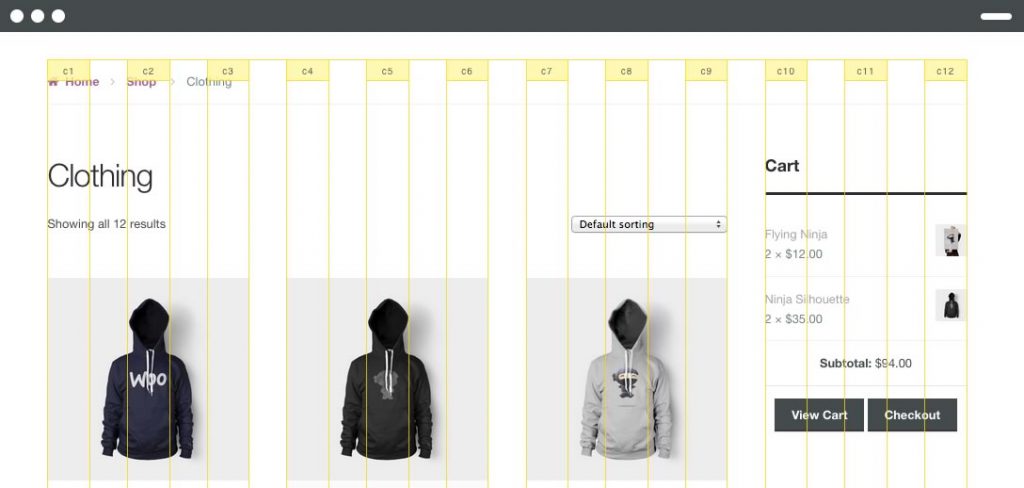
Storefront is the official WooCommerce theme. It is a simple and sleek design that is free to use. It is the foundational theme that child themes are built upon. You will likely need to start at Storefront, but you may be surprised to find that you can stop there, too. The theme is robust enough to be all some sellers need in terms of website design and features.
Features of Storefront include:
BOUTIQUE
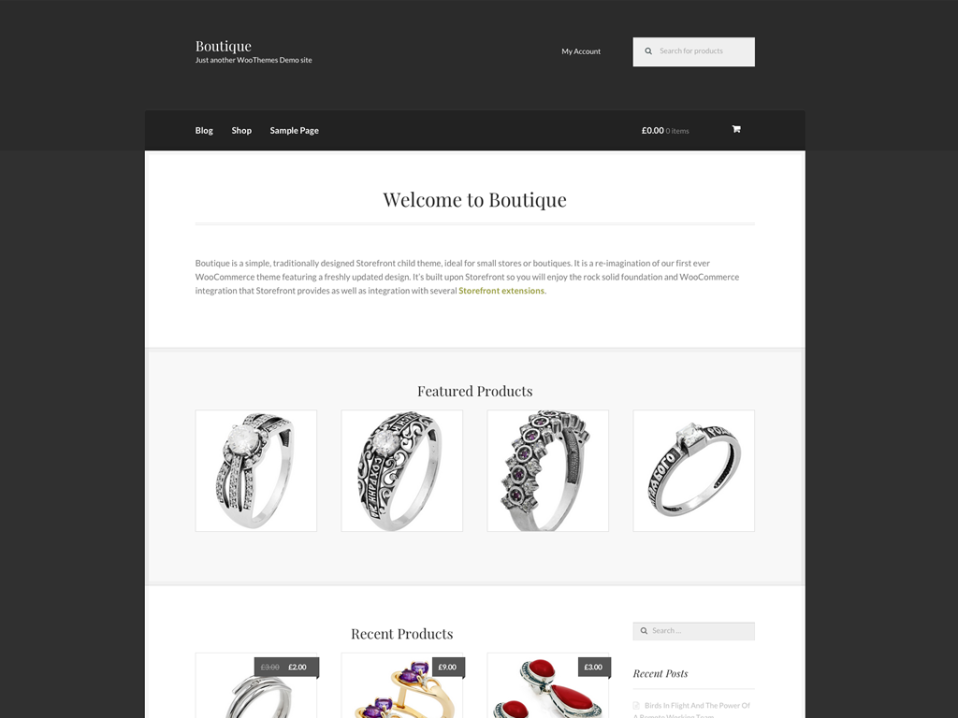
Boutique is a Storefront child theme that is perfect for small stores and, well, boutiques. It is simple and traditional looking, but you can still add your own logo and customize it to make it reflect your store’s needs and personality.
With Boutique, you get all the features and customization options of Storefront, but with a boutique design specifically meant for small stores. Features include:
DELI
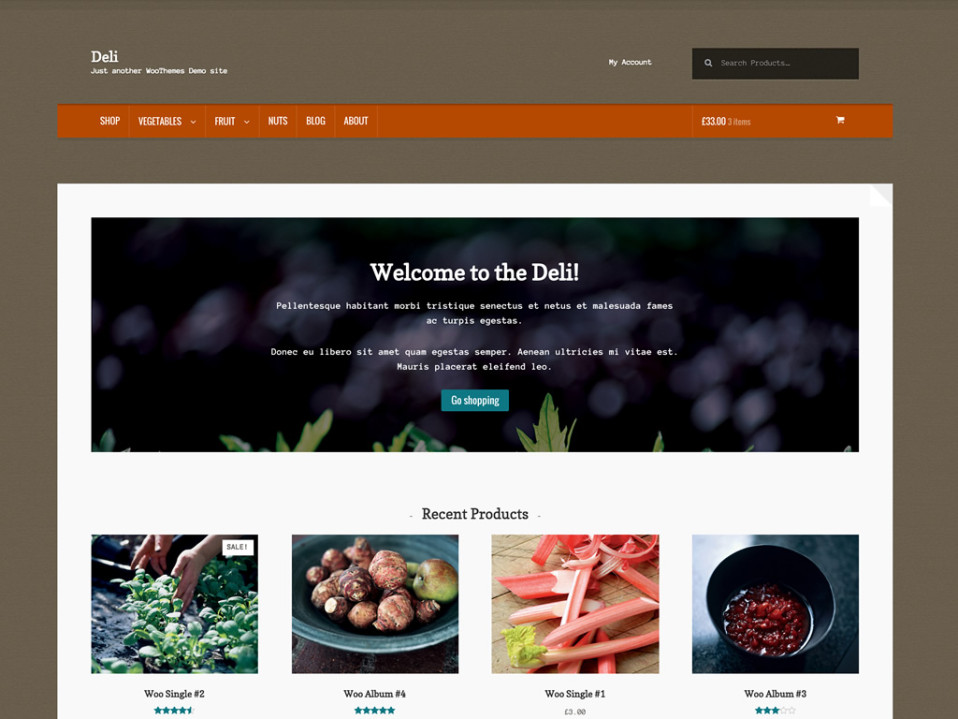
Don’t let its name confuse you. Deli is built for the organic and handmade sellers out there. This theme is actually a great one for people who are choosing WooCommerce over a platform like Etsy for their handcrafted products and artisan gifts.
Deli uses a textured, earthy design that elicits the feel of organic and hand crafted goods. It will appeal to your customers if you are selling products in that field. Features include:
There are only three free themes with WooCommerce. The rest cost $39 to use. Like the other themes, they are built on top of the default Storefront theme.
While you can get WooCommerce themes for free, many of the premium themes are well worth the extra money. They give you more features, more options and more ways to customize the theme and make your store stand out.
GALLERIA

Galleria works with the baseline Storefront theme to product a stellar look for high end fashion and clothing e-commerce stores. It offers a sleek look designed specifically for people selling clothing in the online shop. Features include:
PROSHOP
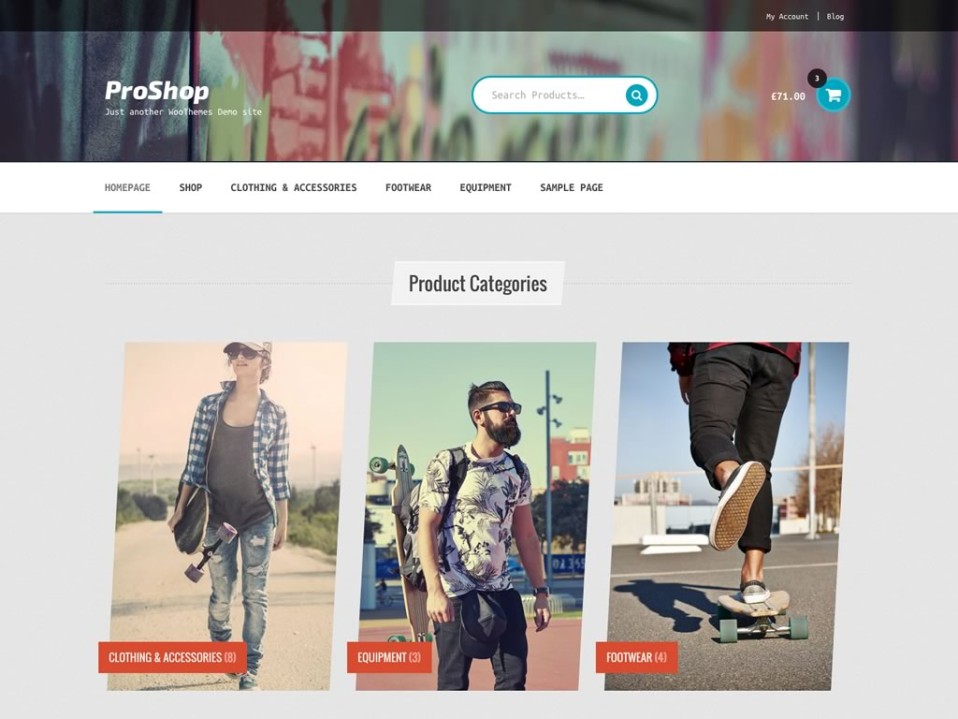
Sell to sports enthusiasts with ProShop. This WooCommerce theme is meant to elicit motion, high speed and fun. It is great for selling sports clothing and equipment. The design of ProSho is urban and textured. Choose the right heading and you’ll have a splashy sporting goods store up and running in no time. Features include:
HOMESTORE
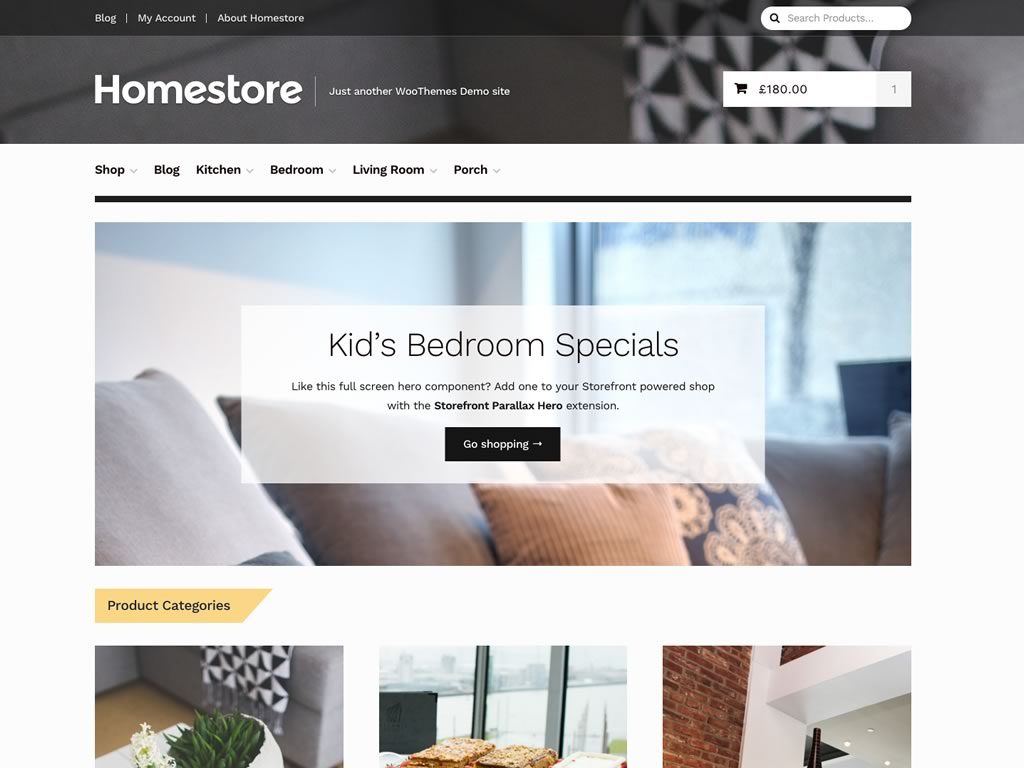
Do you have a home goods or department store? If so, you should definitely consider the Homestore theme. It has a classic department store look with all the features and options of Storefront built it. Modernize department store shopping with this stylish theme for your e-commerce website. Features include:
OUTLET
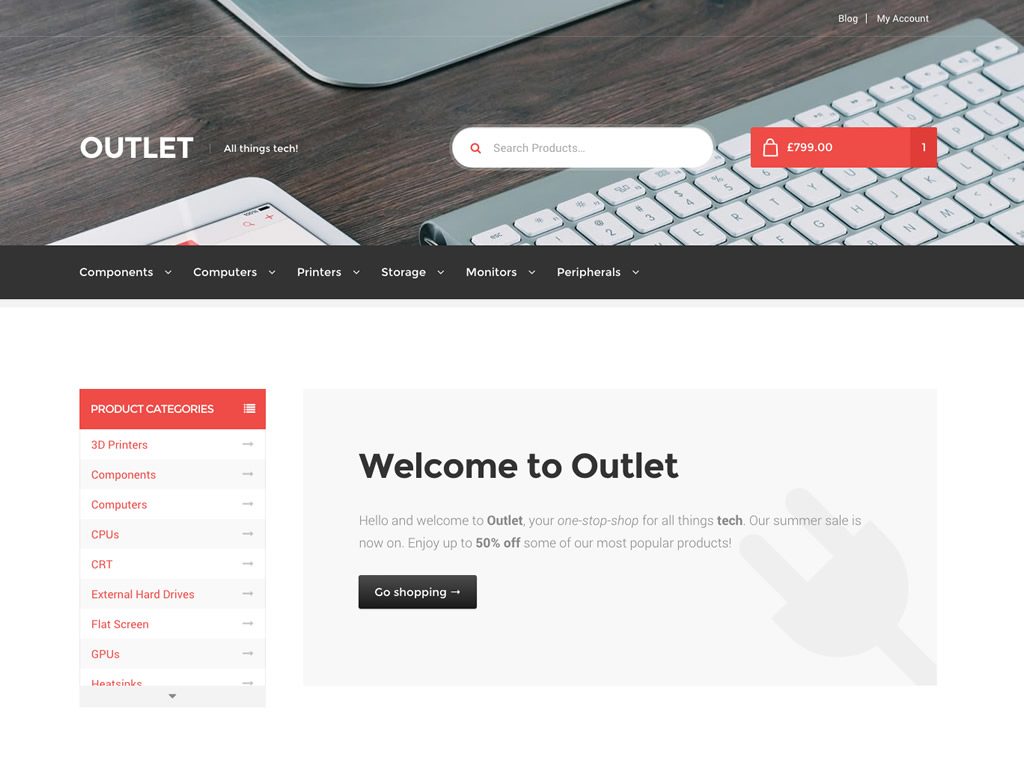
Tech is one of the biggest things sold online. The Outlet theme from WooCommerce is perfect for tech stores online.
People are choosing to buy their tech gear online more and more compared to in physical stores. It’s therefore important to have an e-commerce tech shop that is both easy to navigate and stands out from the crowd. Outlet has a sleek and stylish look that is perfect for tech. The menus and navigation allow customers to comb through sections quickly and easily to find the exact part or piece of hardware they’re looking for. Features include:
TOYSHOP
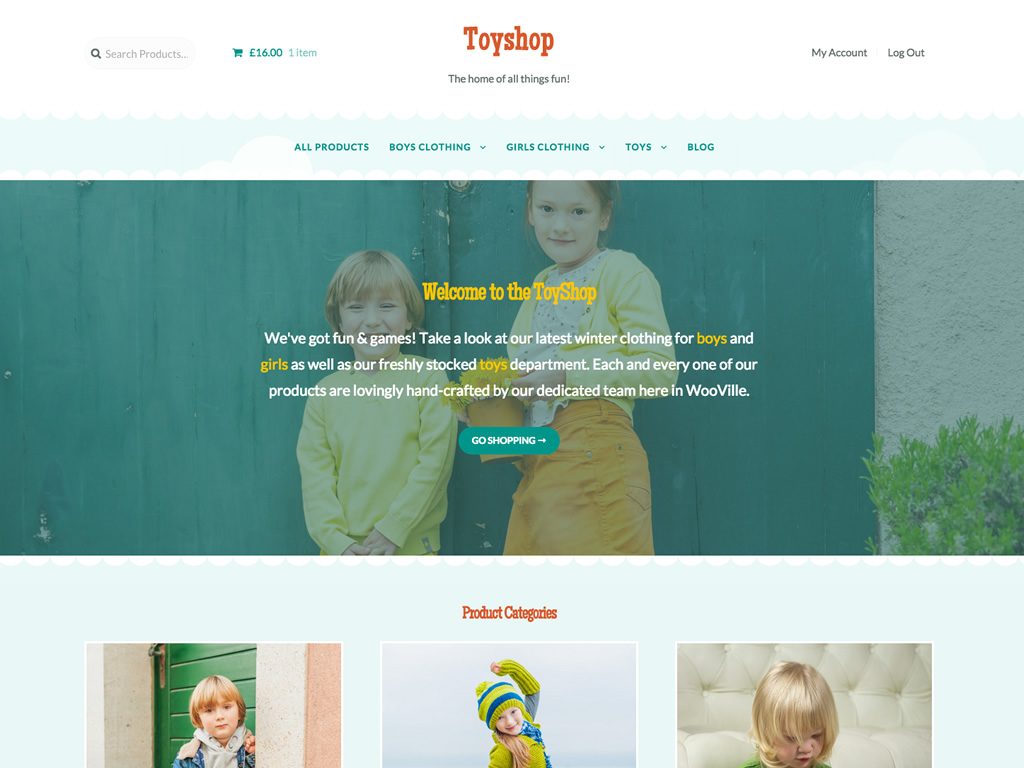
Despite its title, ToyShop is good for more than just people trying to sell toys online. It is aimed at any exciting product, including things like flowers. ToyShop is great for store owners whose customers just want to have fun. The style is light and playful and will visually grab the eye and demand attention. Features include:
BOOKSHOP

Bookshop will make your small or independent book store look like the biggest book stores out there. Product categories are prominently displayed and book covers look big and beautiful. You can sort books by category in a way that will be familiar and comfortable to customers who shop for books anywhere online. The classic design is also appropriate for other collectibles like wine and figurines. Features include:
WooCommerce has even more themes to offer. These were just a few of our favorites. As you can see, however, the themes tend to be specific to certain uses. Bookshop is great for bookshops; Toyshop best suits toy stores.
It’s worth looking at a range of themes before choosing one, though, as themes are versatile enough to be used for a variety of uses. You don’t need to confine Bookshop only to book sellers.
Here are a few more themes from WooCommerce and what we think they do best:
Themes are not the only way you can customize the look and feel of your WooCommerce store. Extensions offer another way to get the precise online presence you’re hoping for with your online shop.
Extensions work hand-in-hand with WooCommerce themes. Whether you bought a theme or are using Storefront or one of the other free themes from WooCommerce, you can tack on extensions to further customize them.
Some groups of extensions are related or fit well with a certain theme or store concept. These come bundled together for a flat price. Prices can range but are usually around $70 for an extensions pack. There are also some free extensions to choose from.
Here’s some of our top extensions picks:
| Extension | Price | Description |
| PayPal | Free | Accept PayPal, credit cards and debit cards through your store |
| Zapier | $59 | Integrate your store with cloud services |
| WooCommerce Memberships Bundle | $299 (varies) | Add a membership service to your website |
| Fulfillment by Amazon | $129 | Connect your store to Amazon’s fulfillment services |
| Stripe | Free | An easy payment system for credit cards |
| Google Analytics | Free | See analytics on your store’s performance |
There are many other extensions and add ons, but things like analytics and payment processing will get you well on your way to having success with your e-commerce store.
When it comes to the best WooCommerce themes, it depends on your store and what you’re selling. But there’s more to it than just picking out a theme. It’s also important to understand what your store needs. Extensions and add-ons can further enhance and improve your store so that it is perfectly specialized for your customers.
In the end, you will give your customers the best experience by combining theme selection with carefully choosing extensions and other add-ons that will hone your e-commerce store into a thriving online business.
To read more articles like – Best WooCommerce WordPress Themes in 2018 for your e-Commerce Business, visit logicinbound.com
There are a daunting number of ecommerce platforms to choose from when starting your online business. Choosing the best one for your startup or ecommerce business requires some research.
We’re comparing the best ecommerce platforms for startups and other businesses in 2018 and beyond. After reviewing some of the top platforms out there for ecommerce, we’ll pinpoint where certain platforms excel in terms of pricing, themes, ease of use and other factors.
If you already have a platform in mind, check out our head to head comparisons of Shopify and Etsy, Shopify and Volusion, WooCommerce and Magento, and more.
In order to pick the right ecommerce platform for your business, take a look at some of the top brands. It is likely that business owners moving into ecommerce have already heard of many of these platforms, but simply haven’t dived any deeper into learning about them.
Many of these platforms offer different levels of pricing in order to cater to a wider range of ecommerce businesses. Some even have free versions. However, lower cost often means fewer special features and add ons. Businesses with very specific needs may find they need to pay a little more to ensure they get all the features they require for their ecommerce business.
Another major consideration is how much effort and time a business can put into their ecommerce platform. Some platforms come with themes and apps to make the work of website construction and management minimal. Others benefit from some amount of coding and website building knowledge. Those who are comfortable with that additional work will get more customized experiences from their ecommerce platform, though. This is often worth the extra work.
Some of the top ecommerce platforms that we’ll review here are:

The big picture:
| Name | Shopify |
| Price | Plans range from $9/month to $299/month |
| For small businesses | Has scaled down options |
| For large businesses | Advanced Shopify and ShopifyPlus are designed for high-volume merchants |
| Themes | Free and Paid |
| Customer Service/Support | 24/7 support available |
| Ease of Use | High |
| Customizability | High if you have some coding knowledge |
Shopify is one of the largest and best-known ecommerce platforms available right now. It powers more than 500,000 businesses and has more than 1 million active users. A huge amount of commerce happens on Shopify, with more than $46 billion sold on the ecommerce platform.
As a platform, Shopify offers a lot of flexibility. You can fully customize your online store and manage your products and inventory with Shopify. Shopify also has a thriving community where shop owners share tips and knowledge and an app so you can keep track of your store anywhere at any time.
While it is one of the most customizable platforms you can find for ecommerce, it does come at a price. Aside from the monthly rate for a plan, many of the themes on Shopify come at an additional cost, though there are some free ones available.
The big picture:
| Name | Wix |
| Price | Plans range from $5/month to $25/month |
| For small businesses | The popular “eCommerce” plan is only $17/month and tailored for small business |
| For large businesses | The VIP plan is better for large businesses but may not meet all their needs |
| Themes | Free and Paid |
| Customer Service/Support | It’s difficult to reach an actual person for help, but there is a support center |
| Ease of Use | Very High |
| Customizability | Low. They are more focused on making their platform easy to use |
Wix is all about ease of use. It has a huge amount of free themes and templates you can use to build an ecommerce platform. It even has an artificial design intelligence feature that builds the site for you via Wix’s AI program. It’s harder to find an easier ecommerce platform builder than Wix.
Wix is also very affordable. The baseline plan is only $5/month. Even their most expensive plan is only $25/month. Of course, with this low price and high ease of use comes a cost. Wix isn’t going to have the bells and whistles that fancier platforms boast, but it should be able to satisfy the needs of most small businesses looking for an ecommerce platform.
The big picture:
| Name | BigCommerce |
| Price | Plans range from $29.95/month to $249.95/month |
| For small businesses | The standard option should suit small businesses |
| For large businesses | There is an Enterprise option that is tailored to large businesses |
| Themes | Free and Paid |
| Customer Service/Support | BigCommerce “University” and other resources aim to answer all your questions |
| Ease of Use | High |
| Customizability | High if you have some coding knowledge |
BigCommerce is most easily compared to Shopify. Both platforms offer a similar experience when building an ecommerce platform. Like Shopify, BigCommerce offers a range of prices and packages tailored to different types of businesses. The platform is highly customizable if you are comfortable with some light coding. It is also possible to use themes and templates to build your website, but some of these will come at an additional cost.
The big picture:
| Name | SquareSpace |
| Price | Plans range from $12/month to $40/month |
| For small businesses | “Professional” version offers a straightforward way to get started |
| For large businesses | “Advanced” version has more features but may not be as powerful as you need |
| Themes | Usable once you have an account |
| Customer Service/Support | 24/7 support available |
| Ease of Use | High |
| Customizability | Medium – customize within templates |
SquareSpace is used by everyone from individuals to businesses. It is a little on the simpler end of platforms and not right for large businesses. It is better for individual’s websites, personal blogs and portfolios and small businesses.
SquareSpace is comparable to Wix and WordPress more than a site like BigCommerce. However, it offers many features that are attractive for smaller websites. If your ecommerce business is on the smaller side, SquareSpace will make setting up an online store pretty simple and painless.
The big picture:
| Name | WooCommerce |
| Price | Price is hard to pin down. You will need a domain and other tools as well as the plugin. Cost can be high. |
| For small businesses | Because it connects to WordPress, it’s great for small business |
| For large businesses | May be too limited for large businesses |
| Themes | WordPress |
| Customer Service/Support | 24/7 support available |
| Ease of Use | Medium – you need to understand WordPress as well |
| Customizability | Medium |
WooCommerce is different from all the other ecommerce platforms on this list because it is a WordPress plugin. This comes with some challenges as well as benefits. In order to use WooCommerce you will need to have some knowledge of how to use WordPress. Because it plugs directly into WordPress, understanding that platform as well is essential.
Also, cost is a bit hard to pin down with WooCommerce. There are costs associated with hosting, WordPress and WooCommerce that can all fluctuate within a range. Any one user’s costs are probably different from any other user’s costs.
The big picture:
| Name | OpenCart |
| Price | Free to download and install |
| For small businesses | Depends on how you use it |
| For large businesses | Depends on how you use it |
| Themes | None |
| Customer Service/Support | Available under GNU General Public License |
| Ease of Use | Low |
| Customizability | High if you have some coding knowledge |
OpenCart is a free piece of software that anyone can download and use. It is meant to adapt to any operating system or ecommerce situation. It does not have much built in to its basic form, though.
OpenCart requires a fair bit of work to use. Many books are available on how to use the platform. If you do have the knowledge and skills to use it, though, OpenCart is a fantastic ecommerce platform. It enjoys success around the world and is one of the most popular ecommerce platforms available.
The big picture:
| Name | BigCartel |
| Price | Price ranges from free to $29.99/month |
| For small businesses | Designed specifically for small, creative ventures |
| For large businesses | Probably not ideal |
| Themes | Free |
| Customer Service/Support | Help Center |
| Ease of Use | Very High |
| Customizability | Medium |
BigCartel is a great platform for small businesses and creative independent ventures. They aim to make selling easy for small stores, with a “quick setup” feature that can get an ecommerce store up and running extremely quickly. They also have a range of free themes. Customizability isn’t super high, but apps and add-ons do allow for some flexibility.
The free version is very limited, but even the most expensive paid version is very affordable. While BigCartel is coder-friendly, using the platform does not actually require any coding.
The big picture:
| Name | OSCommerce |
| Price | Free (open source) |
| For small businesses | Good |
| For large businesses | Good |
| Themes | None |
| Customer Service/Support | Support Center |
| Ease of Use | Low |
| Customizability | Very High |
OSCommerce is free open course software that anyone can download in order to set up an online ecommerce store. About 21,000 live ecommerce stores currently use OSCommerce. OSCommerce also offers more than 8,500 free add-ons that you can download in addition to the platform itself.
Like other open source software, there’s a learning curve with OSCommerce But those who are willing and able to learn how to use the software can get a surprisingly robust ecommerce platform that is genuinely free. Hosting and other costs will fall on you, but once you’re up and running it should be smooth sailing.
The big picture:
| Name | Volusion |
| Price | Ranges from $15/month to $135/month |
| For small businesses | The mini and plus options should be appropriate |
| For large businesses | The premium package may suit your needs |
| Themes | Free |
| Customer Service/Support | Free 24/7 customer support |
| Ease of Use | Medium – some customers have expressed frustration |
| Customizability | Medium – customize within themes |
Volusion compares to platforms like Shopify and BigCommerce. For a monthly subscription, you get themes, support and an all-in-one ecommerce platform that is fairly customizable.
As a platform, it is fairly robust. However, some users have complained about being confused by the user interface and having some difficulty figuring out how to build their store. Volusion does offer lower priced plans than some of the bigger ecommerce platforms, however, and offers 24/7 customer support.
The big picture:
| Name | LemonStand |
| Price | Price ranges from $19/month to $199/month |
| For small businesses | Ideal |
| For large businesses | Probably not appropriate. The “professional plan” only allows up to 1,000 orders per month |
| Themes | None |
| Customer Service/Support | Difficult to use |
| Ease of Use | Medium – you will have to create your own themes |
| Customizability | Very high |
LemonStand targets developers who want to fully customize their ecommerce experience. Such users will find a lot to like in LemonStand. It is fully customizable, top to bottom. Those who want to touch every button and blank space on their site will enjoy this platform.
However, there is a price associated and developers could use open source software to get nearly as much customizability at no cost.
The big picture:
| Name | 3dcart |
| Price | Ranges from $19/month to $229/month |
| For small businesses | Appropriate |
| For large businesses | Can scale |
| Themes | Free and Paid |
| Customer Service/Support | 24/7 support available |
| Ease of Use | High – professional web design packages available |
| Customizability | High |
3dcart offers a wide range of options for whatever sort of business you run. It’s most basic plan is literally called a “startup plan” and is great for small businesses trying to get established in the ecommerce realm. 3dcart does not limit the number of products you can sell, no matter the size of your business.
One unique feature of 3dcart is its professional web design service. 3dcart offers a range of themes to get you started and the flexibility to customize those themes using CSS. However, if you don’t have CSS training or the time to customize your site, you can use their professional web design service to customize your website.
The big picture:
| Name | SparkPay |
| Price | Defunct |
| For small businesses | N/A |
| For large businesses | N/A |
| Themes | N/A |
| Customer Service/Support | N/A |
| Ease of Use | N/A |
| Customizability | N/A |
SparkPay is a lesson is the fickleness of ecommerce and business in general. SparkPay was set up by Capital One bank but has since been shut down. SparkPay will only exist until Jan. 31, 2018, after which it will no longer be supported.
Many things in ecommerce come and go. Platforms that are a hit for a few months soon fall by the wayside. SparkPay is a great example of why stability is important. Platforms like Shopify that have been around a decade or more have proven they can withstand the test of time in the difficult world of ecommerce.
The big picture:
| Name | Magento |
| Price | Price ranges from free to enterprise |
| For small businesses | The free version is appropriate for small businesses |
| For large businesses | Enterprise version should work even for large businesses |
| Themes | Free and Paid |
| Customer Service/Support | Customer support services |
| Ease of Use | High |
| Customizability | Medium |
Magento is similar to platforms like BigCommerce and Shopify. They offer free and paid themes to help you get started, then leave the details of your ecommerce website up to you. There is a free version that is suitable for many small businesses. This can be a big draw, as it will save small businesses a lot of money when they are developing their online businesses.
Magento doesn’t have the extensive support resources of, say, Shopify, which has a larger community and teaching videos. Still, it is a solid platform that can make establishing an ecommerce platform affordable.
The big picture:
| Name | UltraCart |
| Price | Price ranges from $49.95/month to $229.95/month |
| For small businesses | The small business package is customized for startups |
| For large businesses | The large plan is right for most bigger businesses |
| Themes | Available |
| Customer Service/Support | Support and tutorials available |
| Ease of Use | High |
| Customizability | High |
UltraCart tailors its plans for the type of business using them. Starting with small businesses, it offers more features and sales until you reach the large business level.
UltraCart is also easy to use, with a visual builder that doesn’t require any coding knowledge. You can design visually in a way that is intuitive to most people. UltraCart also has video tutorials and documentation available in its support center to help you learn how to use its website builder.
The big picture:
| Name | CoreCommerce |
| Price | Price ranges from $19/month to $600/month |
| For small businesses | Has many lower-cost plans for smaller businesses |
| For large businesses | The higher end plans can suit large businesses |
| Themes | Responsive themes available with all plans |
| Customer Service/Support | Phone number for support readily available |
| Ease of Use | High |
| Customizability | Depends on plan |
CoreCommerce has a huge range of plans available, more than most other platforms. This makes it suitable for just about any business looking to break into ecommerce and start up a store. The amount of choices can be a bit dizzying, though, and CoreCommerce’s own website is not the most appealing. This reflects poorly on the options it can give to its customers.
However, if you are willing to sort through the massive amount of information and difficult formatting on their website, you are almost sure to find the plan that is right for your business.
Small businesses have different needs than larger businesses and individuals. There is a tough balance to strike between getting all the features you need to grow your business while not breaking your budget right away.
Some of the best platforms for small businesses are:
Shopify has been in the business for a very long time. It is one of the most successful platforms out there and still gets good reviews from users. It offers light and reduced cost plans for small businesses that aren’t too expensive. And Shopify’s themes allow for a large amount of customizability.
Magento is similar to Shopify, but can take more time to learn and master. But this learning curve comes with the benefit of even higher customizability than Shopify. Magento can allow you to customize more of your website, if you’re willing to spend more time with it.
WooCommerce is an interesting option for small business. It connects right into WordPress. Small business owners who already use WordPress for their website will find a lot to love with WooCommerce.

Starups have slightly different needs than small businesses. While there is a lot of overlap in between the two, startups are more likely to be innovators and risk takers. We recommend the following platforms for startups:
3dcart literally offers a “starup plan” that is aimed at startup businesses. They are focused on startups and other small businesses and tailor certain experiences toward this.
LemonStand is a platform for web developers who want to fully customize their web development experience when it comes to their ecommerce business. This is good for startups who are trying to innovate and customize. Many startups who are breaking into the business world with something new and creative will appreciate the openness of LemonStand.
Of course, the needs of all startups are different. The big players like Shopify can still work for startups who have the budget for more standard platforms.
When cost is the determining factor, you may need a free ecommerce platform in order to get started. Try one of these:
Magento has many paid options, but its open source free option is also worth considering. You can get many of the benefits of Magento without the cost.
OpenCart offers a basic package for free that you can further customize in order to fit your needs. The OpenCart marketplace offers add-ons if you do find you need more features and have some money to spend on them.
OSCommerce not only offers a free platform, but free add-ons as well. The app marketplace allows you to build a lot of features into your website. As far as a free platform goes, OSCommerce offers a lot of additional options.

SEO is often the job of you, the business owner, but there are platforms that help you with SEO as you build. Here are some of our picks:
WooCommerce, because it integrates into WordPress, comes with a lot of strong SEO features built right in. WordPress will give you feedback on your SEO right in pages and posts. This makes it easy to visually tell if your SEO on any given page or post is strong. This takes the pressure and thinking out of SEO. It will soon become second nature.
Shopify and Magento are similar when it comes to SEO. They both offer tools, add-ons and apps that can help you figure out your SEO.
However, how successful your SEO is on any of these platforms comes down to some extra work on your part. None of these platforms can do SEO perfectly for you. You will have to invest some of your own time and resources in order to get the best SEO possible out of any ecommerce platform.
That depends on how you plan to use it.
For general use, Shopify is hard to beat. It has been an ecommerce leader for a long time because it has been easy to use, customizable and affordable for more than a decade. There is a reason it is so popular.
For startups and small businesses, WooCommerce has a lot to offer by integrating with WordPress.
For those who need to save money, OSCommerce is completely free to use and offers free add-ons to further customize your ecommerce platform.
For SEO, Shopify and WooCommerce both have a lot to offer, but the ultimate success of SEO will still come down to your knowledge and resources.
To read more articles like – Best eCommerce Platform for your Business, visit logicinbound.com
https://www.logicinbound.com/best-ecommerce-platform-business-free-small-startup-2018/